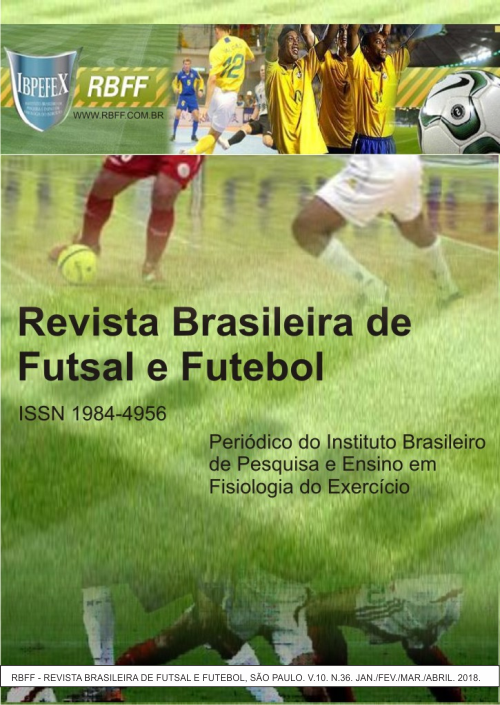Anaerobic threshold determination on youth football players in tests with and without ball
Abstract
Higher anaerobic threshold (AT) means, theoretically, that a player could maintain a higher average intensity in an activity without accumulation of lactate. Thus, the aim of study was to identify the velocity in AT (VAT) in young football players in an incremental test (IT) with/without the domain of the ball during the test. Sixteen adolescents (mean ±SD, 14.5 ± 0.5, 58.0 ± 6.7 kg, 158 ± 11 cm and BMI 22.9 ± 1.2 kg/m2) and they are divided in two group control group (CG, n = 8) and exercise group (EG, n = 8). The incremental test (IT) on training field, which consisted in stages begun in 7km/h with increasing speed of 1km/h every two minutes. The EG performed the IT with the domain of the ball during the test and the CG performed the same situation without ball domain. VAT (km/h) and blood lactate concentration in VAT (mmol/L) were not significantly different (EG, 10.9 ± 1.1 and CG, 11.3 ± 0.7 with p = 0.250) and (EG, 3.4 ± 1.0 and CG, 2.9 ± 0.7 with p = 0.368) respectively. However, Borg scale in VAT was significantly different (EG, 17.5 ± 0.5and CG, 14.5 ± 0.5* with p = 0.005), it represents change in their perceived exertion, "somewhat hard" to "very hard". The involvement with ball, was not sufficient to change VAT or blood lactate concentration on VAT, but, this situation may affect the rating of perceived exertion in young players.
References
-Balikian, P.; e colaboradores. Consumo máximo de oxigênio e limiar anaeróbio de jogadores de futebol: comparação entre as diferentes posições. Revista Brasileira de Medicinado Esporte. Vol. 8. Núm. 2. p. 32-36. 2002.
-Binder, R. K.; e colaboradores. Methodological approach to the first and second lactate threshold in incremental cardiopulmonary exercise testing. Eur. J. Cardiovasc. Prev. Rehabil. Vol. 15. Núm. 6. p. 726-734. 2008.
-Borg, G. A. V. Psychophysical bases of perceived exertion.Medicine and science in sports and exercise. 1982.
-Casajus, J. A. Seasonal variation in fitness variables inprofessional soccer players. Journalmedicineand Physical Fitness. Vol. 41. p. 463-469. 2001.
-Coelho, D. B.; e colaboradores. Limiar anaeróbio de jogadores de futebol de diferentes categorias. Revista Brasileira de Cineantropometria e Desempenho Humano. Vol. 11. Núm. 1. p. 81-87. 2009.
-Edwards, A. M.; Clark, N.; Macfadyen, A. M. Lactate and ventilatory thresholds reflect the training status of professional soccer players where maximum aerobic power is unchanged. Journal of Sports Science and Medicine. Vol. 2. Núm. 1. p. 23-29. 2003.
-Ekblom, B. Applied Physiology of Soccer. Sports Medicine. Vol. 3. Núm. 1. p. 50-60. 1986.
-Eston, R. G.; e colaboradores. The validity of predicting maximal oxygen uptake from perceptually regulated graded exercise tests of different durations. p. 535-541. 2006.
-Graef, F. I.; Fernando, L.; Kruel, M. Heart rate and perceived exertion at aquatic environment : differences in relation to land environment and applications for exercise prescription –a review. Revista Brasileira de Medicina do Esporte. Vol. 12. Núm. 11. p. 198-204. 2006.
-Helgerud, J.; e colaboradores. Aerobic endurance training improves soccer performance. Medicine & Science in Sports & Exercise. Vol. 33. Núm. 13. p. 1925-1931. 2001.
-Junior, M. C.; e colaboradores. Comparação do consumo máximo de oxigênio entre jogadores de futsal que atuam em diferentes posições. Revista Brasileira de Futsal e Futebol. Vol. 6. Núm. 20. p. 146-152. 2014.
-Loures, J. P.; e colaboradores. Specific determination of maximal lactate steady state in soccer players. Journal of strength and conditioning research / National Strength & Conditioning Association. Vol. 29. Núm. 1. p. 101-106. 2015.
-Monteiro, W.; Simão, R.; Farinatti, P. Manipulação na ordem dos exercícios e sua influência sobre número de repetições e percepção subjetiva de esforço em mulheres treinadas. Revista Brasileira de Medicina do Esporte. Vol. 11. Núm. 2. p. 146-150. 2005.
-Ré, A. N. Características do futebol e do futsal: implicações para o treinamento de adolescentes e adultos jovens. EFDeportes.com. Revista Digital. Núm. 127. 2008.
-Santos, P.; Soares, J. Capacidade aeróbia em futebolistas de elite em função da posição específica no jogo. Revista Portuguesa De Ciências Do Desporto. Vol. 1. p. 7-12. 2001.
-Simões, H. G.; e colaboradores. Blood glucose responses in humans mirror lactate responses for individual anaerobic threshold and for lactate minimum in track tests. European journal of applied physiology and occupational physiology. Vol. 80. Núm. 1. p. 34-40. 1999.
-Simões, H. G.; e colaboradores. Lactate Threshold Prediction By Blood Glucose and Rating of Perceived Exertion in People With Type 2 Diabetes. Perceptual & Motor Skills. Vol. 111. Núm. 2. p. 365-378. 2010.
-Stølen, T.; e colaboradores. Physiology of soccer: An update Sports Medicine. 2005.
-Teixeira, J. A. A.; e colaboradores. Caracterização da Composição Corporal, Potência Aeróbia, Anaeróbia e Força de Membros Inferiores de Adolescentes Praticantes de Futsal com Diferentes Frequências Semanais de Treinamento. Revista Brasileira de Reabilitação e Atividade Física. Vol. 3. Núm. 1. p. 29-36. 2014.
Authors who publish in this journal agree to the following terms:
- Authors retain the copyright and grant the journal the right of first publication, with work simultaneously licensed under the Creative Commons Attribution License BY-NC which allows the sharing of the work with acknowledgment of the authorship of the work and initial publication in this journal.
- Authors are authorized to enter into additional contracts separately for non-exclusive distribution of the version of the work published in this journal (eg, publishing in institutional repository or book chapter), with acknowledgment of authorship and initial publication in this journal.
- Authors are allowed and encouraged to post and distribute their work online (eg, in institutional repositories or on their personal page) at any point before or during the editorial process, as this can bring about productive change as well as increase impact and impact. citation of published work (See The Effect of Free Access).





